The creator of one of the most famous paintings in the world, 19th century artist Katsushika Hokusai certainly left his mark not only on the art world but on world culture as a whole. As part of his series entitled Thirty-six Views of Mount Fuji, his famous print, The Great Wave Off Kanagawa, depicts a great Prussian-blue wave tossing boats around in the frothing ocean, with Fuji visible in the background. Carved as a woodblock print back in 1831, when the master was in his seventies, this piece of artwork not only showed the mountain in all its glory, but has been analysed since as representing a threat from overseas from other nations, threatening to overwhelm the Japanese way of life and drown its spiritual monument, the mountain itself, which had long been a site of religious and spiritual reflection, and continues to be to this day.
The Great Wave may well be his masterpiece, reprinted possibly billions of times by now, but this wasn’t all the artist completed. Another of his series was entitled Hyaku Monogatari (One Hundred Ghost Stories), created in around 1830. Despite the name, it somehow only managed to get to five pieces, which is a shame, because they’re a wonderfully disturbing few images of spooky madness from nearly 200 years ago. Any horror fan worth their salt would do a lot worse than to spend some time admiring them.
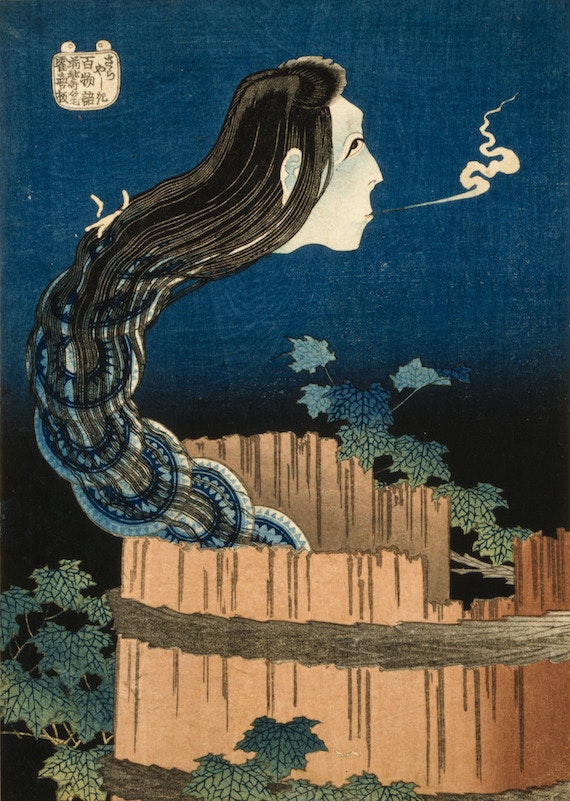
The first of the five prints is entitled ‘The Mansion of the Plates’, and draws its inspiration from one of the same stories that inspired Koji Suzuki’s novel Ring, that of the story of the ten plates and the ghost of Okiku. A maid accidentally breaks one of a set of plates belonging to her master, who in a rage, kills her and throws her down a well. Later she returns from the well as a spirit to wreak her revenge. Versions of this story have Okiku as completely innocent, with both her master (or would-be suiter) hiding the plate and then blaming her, or his wife hiding the plate. In all of these cases, it doesn’t end well for poor Okiku. Interestingly enough, a species of bug discovered in the late 1700s was known as ‘Okiku Mushi’, or the Okiku bug, named after the maid who was killed.
Koji Suzuki would take the ‘bug’ into technological realms when Sadako becomes the ghostly-tech hybrid infection of the ‘Ring virus’ in Spiral and Loop, the second and third books in the Ring series respectively. In his painting over 150 years prior, Hokusai’s painting of the story is beautifully bizarre, with Okiku’s neck stretching from out of the broken well like a great worm, the plates forming her neck show her fusing with that which caused her misery all that time ago.
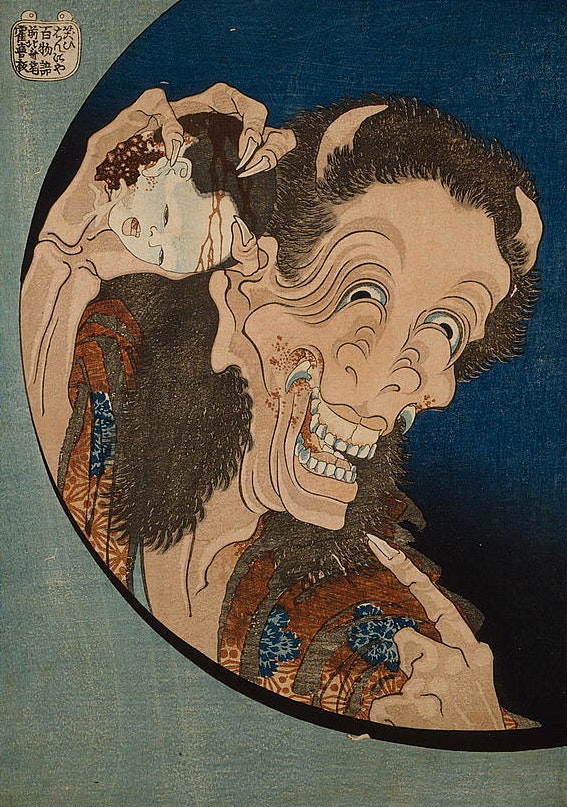
In The Laughing Hannya, one might recognise the kind of face which would become popular to oversees audiences through the mask in the 1960 film Onibaba. A horned demon laughing with blood around its face, the child’s head in its clawed hand, blood dripping from the crown, is immensely disturbing. What a beautiful job Hokusai had done with the woodblock, however, managing to carve in a way to so much detail into the hair, so many tiny strands, set apart from the relatively plain face of the demon-transformed woman (or ‘hannya’, hence the title), save for the speckling of blood on its maw. The skeletal hands really set it aside as something horrific and monstrous, cannibalistic and unholy.
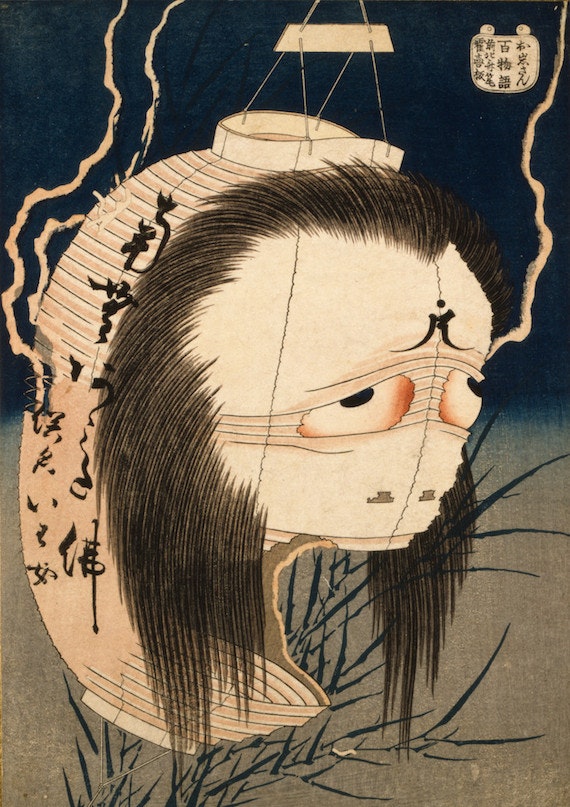
Stories of spurned lovers continue to haunt horror films from Asia even now, and their imbuing themselves with physical items as a form of their manifestation gives them an additional sense of dread. Marley’s ghost might have been transfiguring door knockers over in England, but years before that there was a samurai’s wife thrown away after his new lover’s friends give her a face cream that poisons and disfigures her. Hokusai shows the spirit of Oiwa in the painting of the same name, possessing and disfiguring a paper lantern in a print of the same name, usually seen as a sign of good luck and happiness to guide spirits to the afterlife, to claim her revenge, twisting good into bad. Using the lantern’s sections to break apart the spirit’s face, like a snake unhinging its jaw, eyes red and raw, the whole image presents such an uncanny intrusion of the bizarre into the normal that it’s almost impossible not to be transfixed by its awfulness.
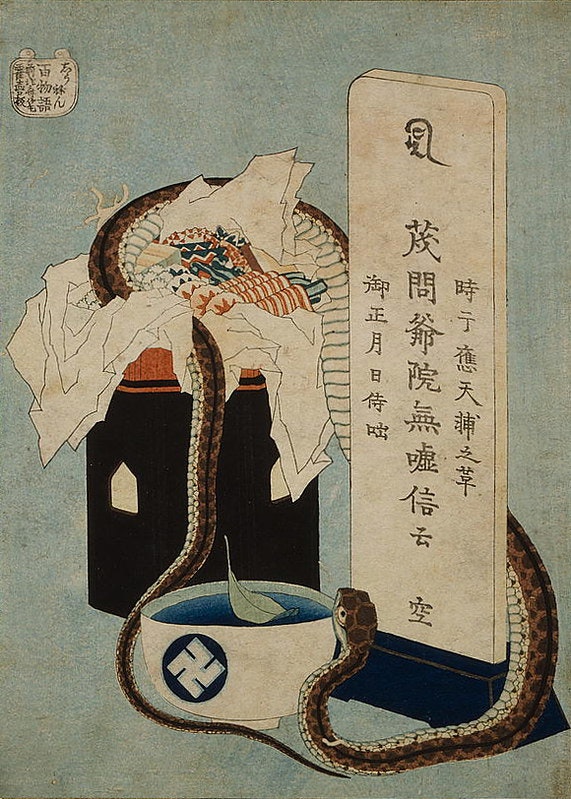
Back before a century ago, a swastika was seen as a sign of good luck and hopefulness in many cultures, including Buddhism. It is therefore fitting that an oroborous-like snake, symbol of eternity and never-ending emotion, surrounds it in the print Obsession, which also depicts a memorial tablet and offerings on a Buddhist altar. An emotion that could go beyond even the realms of death, that such a powerful feeling would be represented by a snake (seen as evil in many cultures, not just Christianity and the Indiana Jones films) gives the painting a worthwhile feeling of ugliness. It’s not a scene anyone would want to come across, and whilst perhaps not as visually striking as the others in the series, it’s much more symbolic and universal in its depiction of the ghostly retention of ideas after departure.
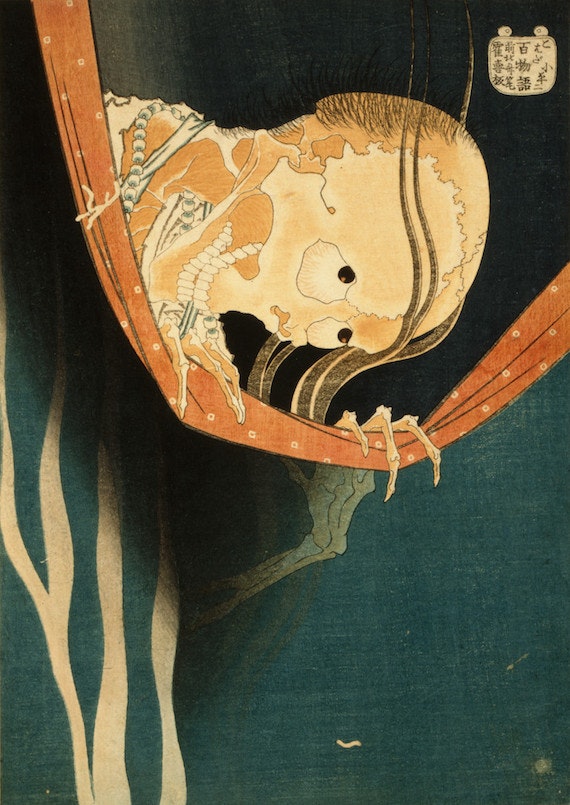
The final print in the series, Kohada Koheiji, touches upon a real-world incident. The eponymous man of the title, an actor believed to have lived in the later Edo period, is murdered by his wife her lover. Returning, mosquito-like, he rises in a mix of skeletal hands and insectoid fronds to peer over the mosquito net of his wife’s bed. The story had already been novelised and adapted into several kabuki theatre plays by the time Hokusai got around to his version, so he had to do something different to stand out. It’s therefore not surprising that this one is the most gruesome of the paintings, even beyond The Laughing Hannya, with Hokusai depicting a cracked skull, fleshless and leering jaws, and once again the pupils in the top of the sockets, looking up. Doing this with all his faces (aside from Hannya) gives the spirits not only a sense of uniformity, adding to their identity as part of a woodblock series, but makes them just that little more strange. We’re used to looking straight on at things, and spirits looking to the tops of their heads makes them seem a little more deathly, as if the eyes that rolled to the heavens upon their passing have been locked in place. The two tones of blue, lighter for the net and darker for the sky beyond, gives the print just a little extra surreal strangeness.
The sequence is a great little series of prints from back in the day, especially before photography. Although magic lanterns had been shown in Japan for a few decades, thanks to the introduction by the Dutch (the only country they annually traded with for over a century), woodblock prints were much more the norm for visual art, becoming more and more common for the average individual to possess works of art in their homes as time went on throughout the 18th and 19th centuries. Bringing these prints to story telling groups, where candles would be extinguished one after another until, with the final one gone, a ghost would appear, would also help get one in the right mood for terror. In today’s world, they’re obviously much overlooked by Hokusai’s other artistic achievements, but they nonetheless remain a wonderful window into spooky, horrific media nearly two hundred years old.




 HorrorAddicts.net Season 19
HorrorAddicts.net Season 19








 HorrorAddicts.net Press Presents:
HorrorAddicts.net Press Presents: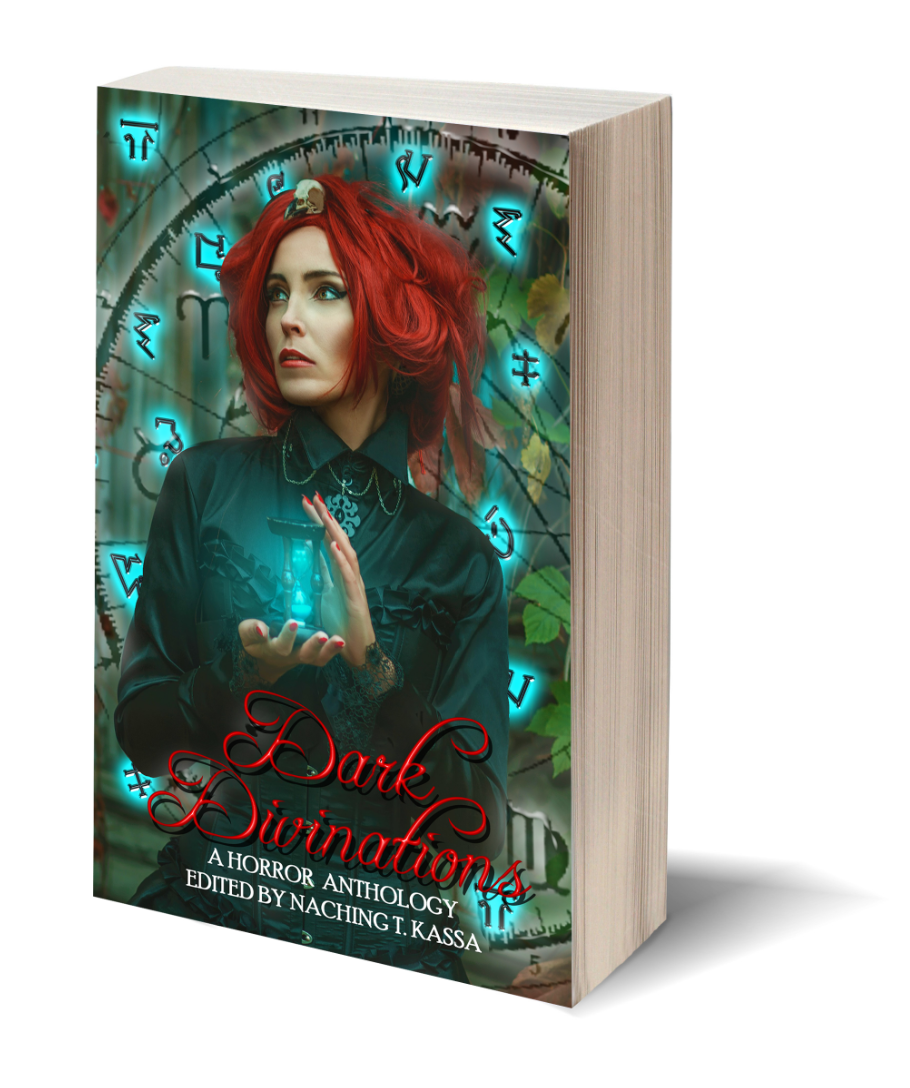










 Featuring work by:
Featuring work by:







 A Horror Disaster Anthology
A Horror Disaster Anthology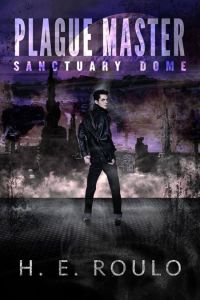



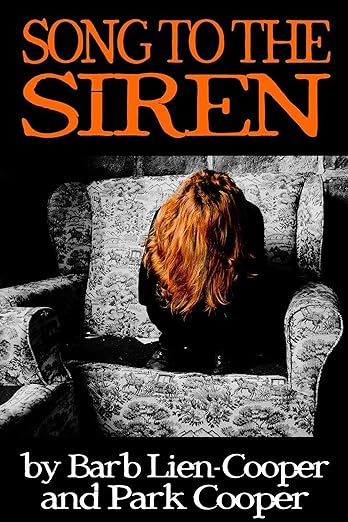 Sam Mac is an acclaimed photographer who grew up with the members of the infamous band, Big Carnival. With one member being her brother and the other the only man she ever loved, an interview with her is a dream come true. Indie documentarians Brandon and Ryan hit the jackpot when Sam Mac invites them to stay in her home and record what really happened to the band–especially the circumstances surrounding the lead singer Reed Sinclair’s death.
Sam Mac is an acclaimed photographer who grew up with the members of the infamous band, Big Carnival. With one member being her brother and the other the only man she ever loved, an interview with her is a dream come true. Indie documentarians Brandon and Ryan hit the jackpot when Sam Mac invites them to stay in her home and record what really happened to the band–especially the circumstances surrounding the lead singer Reed Sinclair’s death.














 Inside, you’ll find nine stories mostly related to death, dying, or ghosts with a little supernatural stuck in. There are some good ideas in here that mostly remind me of the TV shows The Twilight Zone and Amazing Stories. These tales are open-ended and largely have no resolution, but the ideas are interesting. I’m not sure what Insomnia has to do with the stories unless it’s because they were written when the author had insomnia? Maybe she thinks it will cause insomnia, but for the hardcore horror addict, these won’t do that.
Inside, you’ll find nine stories mostly related to death, dying, or ghosts with a little supernatural stuck in. There are some good ideas in here that mostly remind me of the TV shows The Twilight Zone and Amazing Stories. These tales are open-ended and largely have no resolution, but the ideas are interesting. I’m not sure what Insomnia has to do with the stories unless it’s because they were written when the author had insomnia? Maybe she thinks it will cause insomnia, but for the hardcore horror addict, these won’t do that.

 Was our full version with week-by-week updates too much for you? Now we have a slim version that is only the month spreads plus all the other sheet goodies in the back. Need a thin version to carry with you? Don’t want to have to write in it everyday? This new SLIM version is for you!
Was our full version with week-by-week updates too much for you? Now we have a slim version that is only the month spreads plus all the other sheet goodies in the back. Need a thin version to carry with you? Don’t want to have to write in it everyday? This new SLIM version is for you!



 Telling haunted tales at Christmas is a tradition I was so excited to hear about a few years ago. After reading The Woman in Black and realizing that telling spooky tales was a “thing” that people actually used to look forward to during the holidays, I deep-dived into the history and just couldn’t get enough. These were
Telling haunted tales at Christmas is a tradition I was so excited to hear about a few years ago. After reading The Woman in Black and realizing that telling spooky tales was a “thing” that people actually used to look forward to during the holidays, I deep-dived into the history and just couldn’t get enough. These were  It’s rare to find a Christian Horror novel and even more rare to have it submitted to HorrorAddicts.net for a review. If you are a Christian who loves Horror or a Horror reader who doesn’t mind seeing the story told through the eyes of Christians, this book is for you.
It’s rare to find a Christian Horror novel and even more rare to have it submitted to HorrorAddicts.net for a review. If you are a Christian who loves Horror or a Horror reader who doesn’t mind seeing the story told through the eyes of Christians, this book is for you. 